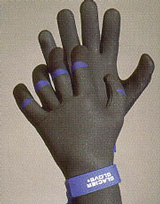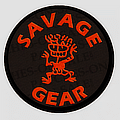|
|
Glacier Glove
Glacier Glove
$39.93
I love these gloves. There's no question, they are the best gloves I have used for ice climbing. Recently I wore them all day for ten day's climbing in the North Conway area, staying on the sharp end for just about all of the pitches I climbed. With temps ranging from 15 to 30 during the day and they were warm, comfortable and worked excellently for leading both ice and rock routes.
The Glacier Glove Company makes two styles of neoprene gloves. The 802 is 2 to 3mm of neoprene with a very thin micro-fleece layer bonded to the inside. The neoprene in the model 002HBL is of similar thickness but with a reinforced neoprene palm and fingers of a material called Hypalon. However, it does not have the micro-fleece lining. Both models have pre-curved, articulated knuckles and a Velcro wrist strap.
Contrary to popular impression, neoprene is not waterproof. The gloves do get damp and sometimes wet inside, as moisture travels through the material. But, as with a diving wetsuit, they are just as warm when wet. Fortunately they were not so clammy that I got raisin-finger, just damp. It was nice to change into dry gloves at the end of the day, but that has been true with every other pair of gloves I have used in the last ten years. I would suspect that the very thin micro-fleece lining in the 802's helps transport some moisture away from the skin. The softness of the inner lining does keep them feeling quite comfortable, and it doesn't slip around since it's actually bonded to the neoprene.
The main difference between Glacier Gloves and most other 'ice climbing' gloves is that they are only one layer thick. This monolithic construction, combined with the stickiness of the neoprene and the snug fit, means that they have excellent tactility and control. They really are like a second skin. I can easily manipulate gear, operate spin-ball lockers, sort nuts, and untie knots. I never needed to take them off during the day. They climb rock well enough that I could securely hang off a hand-jamb in a flaring crack. My ice tools have a rubber grip and the neoprene stuck to it like guano, and the sense of grip helped me relax my hands. Nice too that neoprene is good enough armor to take the sting off a misjudgment of knuckle positioning. They can not be perfect, you say? True, there are some weaknesses. Glacier Gloves are not for really cold days. Below about 15 or 20 you would need more insulation unless you were moving fast. Model 802's are not very durable. They are great for climbing, ok for belaying, but not for rapping. So I lied about not needing to take them off! I kept them on, but kinda shredded the palm in the second day of climbing. It is not too-too bad and I am sure that they will last at least the rest of the next half of the season. But they are not extremely durable.
The Hypalon palm model 002HBL is the one that Glacier Glove markets specifically for ice climbers. Supposedly they are endorsed by Jeff Lowe. The Hypalon feels just like the regular neoprene but it is claimed to be more durable. So far this appears to be true. Rope handling over two days has yet to shred them so they are at least a step ahead of the 802. Unforunately the Hypalon model does not have the micro-fleece lining. I like the lining and I can not see a reason to omit it. Hopefully future models will have both.
The Velcro wrist strap got in the way of my ice axe wrist loops so I snipped it off. This was an improvement. If you try the gloves and get hooked on how well they climb, try getting a pair of insulated mitten shells to throw on at belays and when rapping. This makes them more useable on cold days and will help them last longer. One caveat too is that Glacier Gloves take forever to dry unless you turn them inside out. And that is not a really easy thing to do. Hang them a couple feet over a radiator or good heat source and they will likely be dry the next AM, else three days in the cool basement. Dive shops sell special neoprene deodorizing detergent that might be a good idea.
Be careful with sizing. I usually fit large size gloves, but the medium pair of Glacier Gloves I got is just a tad loose in a few spots (over the knuckles, and that helps flexibility). Do not get a tight fit, as it will constrict your circulation.
I feel so enthusiastic about both the models that I recommend them highly. They are a pleasure to climb with, are half the price of many of the other specialty ice gloves on the market and they work so much better. Both models retail for $39.93.
Special thanks to Tim at Craggers in North Conway for the review samples.
Jamie Leef
February 2003
|














